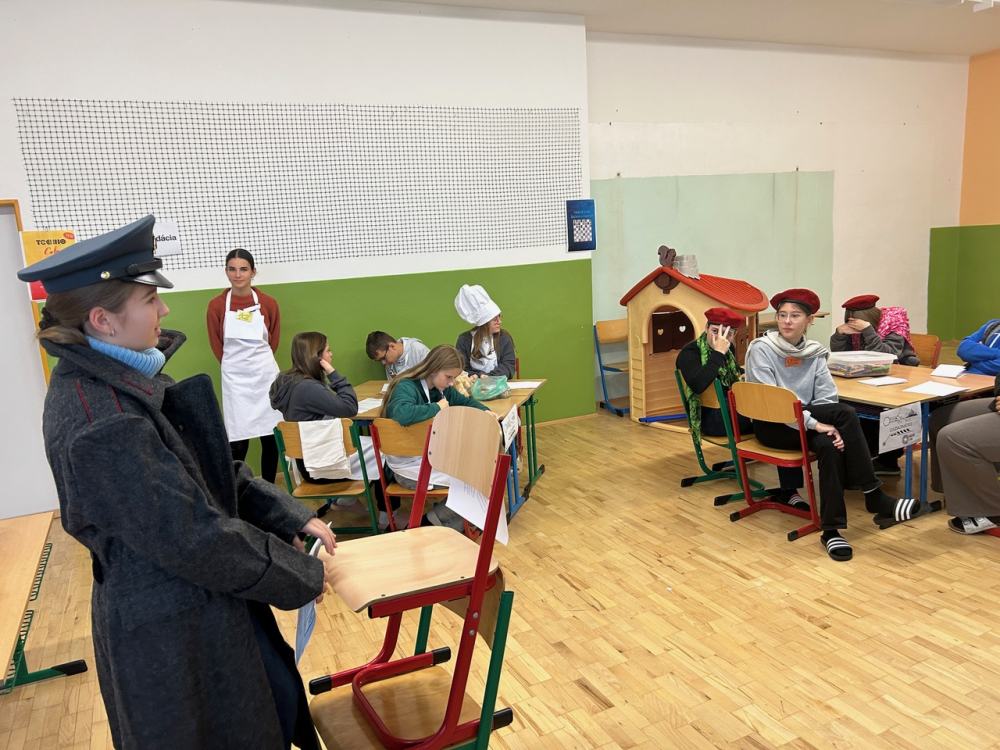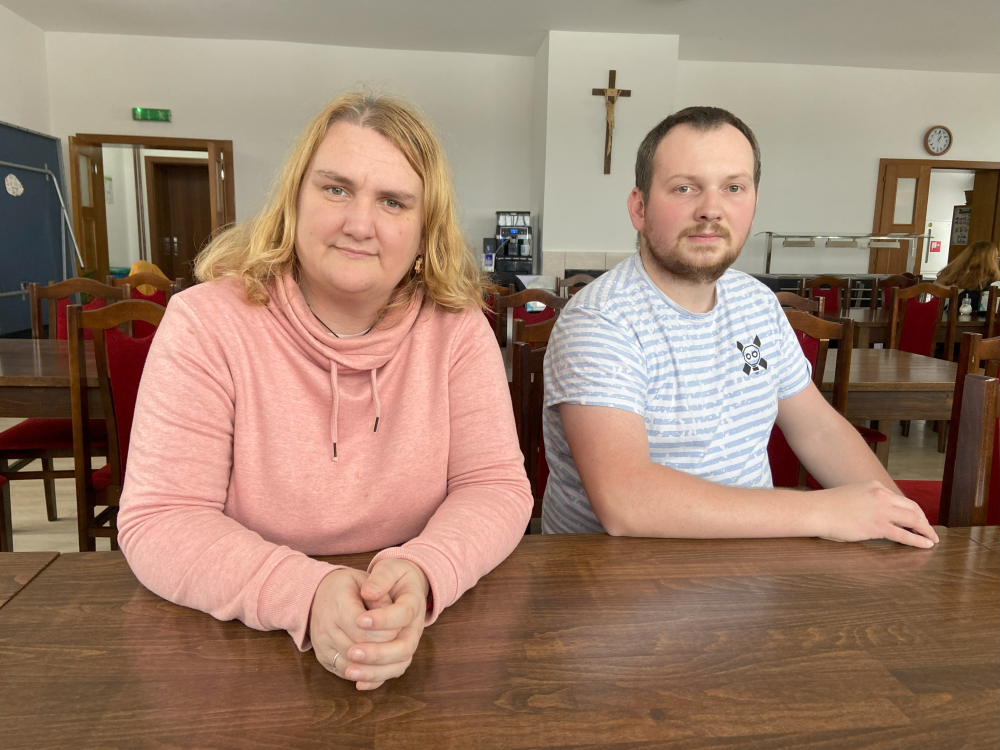Empowering Youth Against Disinformation Through LARP
In their Local Action, the OZ VIAC has developed an innovative live-action role-playing game (LARP) designed for young people aged 13 to 18. This immersive game helps participants understand the negative impacts of disinformation while developing critical thinking skills and confronting personal biases.
LARP employs educational methodologies to create a dynamic environment where youth can engage in scenarios that expose disinformation challenges. Apart from the LARP scenario, OZ VIAC produced 10 audio recordings for hearing-impaired individuals, along with introductory video content that facilitates understanding of the role-playing experience.
 LARP on disinformation. Photo: OZ V.I.A.C.
LARP on disinformation. Photo: OZ V.I.A.C.
Interview with Romana Michaela Michalíková (the project manager of OZ VIAC) by Ľubica Stanek (PDCS)
If you don’t happen to have a car, the journey from Bratislava to the Orava Youth Center in Ústie nad Priehradou is an adventure in itself—you’d need to take a train, then a bus, and finally walk. In December 2024, Ľubica Stanek from PDCS met Romana Michaela Michalíková, the project manager of OZ VIAC – Institute for Youth Support and Development, during a gathering of various non-governmental organizations. Under their guidance, we participated in a new live-action role-playing game focused on the topic of disinformation.
 Romana Michaela Michalíková, project manager, and Lukáš Vojtuš, who leads the LARP role-playing games. Photo: L. Stanek
Romana Michaela Michalíková, project manager, and Lukáš Vojtuš, who leads the LARP role-playing games. Photo: L. Stanek
Tell me about why you decided to join the Digital Activism Program.
We realized that as an organization, we lacked knowledge in the areas of disinformation and cybersecurity. We experienced a situation where hackers attacked our website, and it took us two years to fully recover and rebuild it. We knew we weren’t doing anything in cybersecurity for young people either. During conversations with them, we often see that they believe all sorts of nonsense—not just information from the online space, but also things they hear in real life and immediately believe.
As an organization and community, we face many attacks in the real world as well. People know nothing about us, yet they actively spread their opinions about us—because, well, it’s Orava. We feel the negative impact: young people who come to us often already have preconceived notions. They form opinions from a distance, and it takes time to break down those barriers.
What are the young people you work with like, and what’s life like for them in Orava today?
We mainly work with young people aged 14–18. We see two extremes. Some are very active, open, eager to bring about change, participate, and move forward. On the other hand, some are confused, struggle with low self-esteem, and have been labeled since childhood. They face significant problems in relationships—they might claim they know how to live and form connections, but in reality, they struggle.
We observe that many young people lack the courage to try new things. If something seems difficult, they retreat, often without even knowing what lies ahead. They activate their natural defense mechanisms and disengage. Sometimes, even after arriving here, they prefer to stay in their rooms, connected to Wi-Fi. Their first question upon arrival is often: “What’s the Wi-Fi password?” However, we don’t provide it, and they find this challenging. Many young people live in isolation—they go to school and then spend their time online at home.
Do you notice any broader trends affecting young people’s lives in Orava?
We see they often lack positive role models to follow. They need healthy, functional communities, but these are often absent. In some places, they exist, but for the most part, they are missing. Young people need supportive communities to push them forward, not ones that lead to pathological relationships.
There are significant social disparities among young people. At our community center, we also work with children from socially disadvantaged backgrounds, and the differences are stark. Young people from these groups often experience failure and are labeled as problematic. As a result, they present themselves as problematic—it’s their way of seeking attention. However, their self-esteem is at rock bottom.
I feel that young people today are grappling with the question of who they are and what the purpose of their existence is. They often ask: “What should I do to be loved?” They search for answers in various ways, but unfortunately, not always in the best ones.
How has your participation in the Digital Activism Project impacted your NGO?
As an organization, we’ve come to fully understand the importance of cybersecurity. While we’re still at the beginning, we’ve already set specific steps to protect ourselves better. Now we know what to do to avoid situations like the one two years ago. This is, in my view, the greatest benefit of the entire initiative.
Another significant gain was creating specific tools that allowed us to delve into disinformation from various perspectives—for instance, working with parents from disadvantaged backgrounds, cybersecurity, and developing a disinformation-themed LARP (Live Action Role-Playing). We’ve gained not only valuable experience for our own protection but also tools that open up this topic to different target groups.
In our work with parents, we created a podcast series to motivate them to take control of what their children do online. For example, we met a mother who knew her child spent too much time on the phone but was afraid to take it away because it caused major conflicts between them. She didn’t realize that as a parent, she needed to set boundaries, not her child. This was one of the topics we addressed, emphasizing the importance of boundaries. Parents received concrete tools and tips on how to proceed—for example, how to talk to young people and set rules to protect children online.
At OZ VIAC, we have a long-term goal of prevention using innovative tools like experiential learning through LARP. We want young people to feel how easily they can be influenced and, at the same time, understand how disinformation works.
Let’s talk more about the LARP. What feedback do you get from participants?
Most young people enjoy playing—it’s an attractive method for them. Their feedback is very positive. Every group takes away something specific that helps them change their attitudes. We’ve never had a group that wasn’t affected by the LARP. Every participant could identify with the character they played. This identification helped them better understand the situations they experienced and see the broader context of disinformation.
What are the main insights participants gain from the LARP?
Young people often realize they need to be more cautious about the information they consume and learn to verify it. They are frequently surprised by how easily they can be influenced during the game. We always complement the LARP with follow-up activities that deepen the overall impact. In feedback sessions, many participants admit their knowledge of disinformation was very limited and that they’ve learned mechanisms for verifying information.
When they experience moments of surprise during the LARP, they often say they didn’t expect it at all. This leads to reflection—they realize they might genuinely live with certain misconceptions they hadn’t been aware of.
What has the new disinformation-themed LARP brought to OZ VIAC?
Each design requires skill development and constant learning. During the design process, you must overcome obstacles, solve problems, and continually improve. Before this, we typically created LARPs for 10–20 participants. Thanks to the project, we were able to prepare a large LARP for 30 people, with the new theme of disinformation. Expanding this theme and creating a larger format has been a major benefit for us.
We intend to incorporate the disinformation-themed LARP into a comprehensive program. This program will include multiple activities—for example, after playing the LARP, we’d visit schools several more times to conduct follow-up activities that strengthen young people’s understanding of disinformation.
Author: Ľubica Stanek, PDCS
Ľubica Stanek works as a lecturer and consultant at PDCS, specializing in communication with a focus on value-based narratives and storytelling.
Background illustration: OZ VIAC
This Local Action was implemented in partnership with PDCS - Partners for Democratic Change Slovakia
 Read the Slovak version here.
Read the Slovak version here.